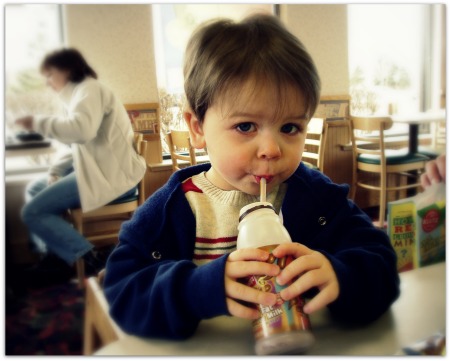You never change things by fighting the existing reality.
To change something,
build a new model that makes the existing model obsolete.-R. Buckminster Fuller
Look, I want to start off by saying I love Jamie Oliver and everything he’s trying to do, and every time I watch Food Revolution I wind up yelling at my TV screen in a futile attempt to shame the mean people who stubbornly stand in his way. Fight the power, Jamie. Right on right on.
That being said: I’m seeing people celebrate the removal of chocolate and strawberry flavored milk in L.A. schools, a major campaign in this season’s Food Revolution, and the victory feels hollow at best.
Yes, flavored milks contain more sugar, and yes, about 60% of the cartons of milk kids choose at lunchtime are flavored. But let’s be real.
Give kids a choice between white milk, apple juice and orange juice, most kids are going to choose the juice. End of story.
All you’ve done is swap one kind of sugar for another.
____________________________________________________
But Robin, you may ask, why don’t kids just drink water instead?
Why, that’s an excellent question. I’ll tell you why. Because schools are reimbursed by the federal government for the milk kids purchase; that’s true of orange juice too. But they receive no reimbursement for water, tap or bottled, because water provides no measurable nutritional value.
I’m not blaming the schools, really. They have a very tight budget to work with and they are required to meet certain nutritional thresholds to receive their federal reimbursement, so every food is chosen based on their ability to be checked off a list of standards (which is why we get ketchup counting as a fruit/veggie).
But seriously, come on. Kids need water.
They need about 8 glasses a day— more for bigger kids, and during warmer months— and since they’re spending at least half their day at school, logically they should be getting at least half their water intake there.
And yet, AND YET: how many water fountains are there in a typical school? One for every, what? 100 students? 200? More? All lined up for water? How much can they possibly take in?
Ever drink from a water fountain? I won’t, and I’ll tell you why. They’re nasty. The water almost always tastes terrible. Metallic. It’s rarely cold. Half the time the water just barely dribbles off the faucet so you have to get your mouth right up in there. There’s no way to know what the quality of the tap water is like. And?
Water fountains are petri dishes. You know it, I know it, I don’t really want to think about it so let’s move on.
______________________________________________________
The CDC’s National Health and Nutrition Examination Survey estimates that only 15% of tweens consume enough water. Why is this worrisome?
- Mild dehydration— defined as 1%-2% water loss; by way of comparison a supremely hardworking athlete can lose up to 30%— can negatively impact a kid’s mood, energy levels, concentration and ability to learn.
- Mental performance (memory, attention and concentration) is reduced by about 10%, once a kid is dehydrated enough to notice they are thirsty. Performance levels worsen as the level of dehydration increases. Water is an essential element in neurological transmissions; the brain is mostly water, after all (about 80%).
- Long-term, chronic dehydration can lead to constipation, continence problems, kidney and urinary tract infections, kidney stones, and potentially some cancers (some studies suggest drops in cancer risk were specifically associated with water, rather than other fluids). Nighttime bed-wetting could also be caused by daytime dehydration affecting bladder capacity. [source]
- A Journal of Pediatrics study showed that giving kids more access to water— water fountains in schools and refillable water bottles— along with educating kids on the benefits of drinking water decreased the risk of being overweight by 31%.
___________________________________________________________
We need to get more water, quality water into our kids, all day long. Measurable amounts, not just rushed sips from questionable fountains.
Then we can tackle the even larger problems of the lunchtime menu: the over-processing, the sodium, the lack of fresh ingredients, the indoctrination of a fast-food mentality.
For some kids it’s the best meal they get all day. And yet prisoners receive more balanced, nutritious fare.
We’re celebrating taking flavored milk off the menu, but offering water is not an option. There is something fundamentally flawed about this thinking. The fundamental thinking has to change. The budget allocations have to change. The cutting corners to save a few pennies at the cost of our children’s health has to change. The factory model just isn’t working anymore, and no small swaps are going to mean enough to make a difference.
________________________________________________________
Jamie Oliver is trying his best to make a difference: to get kids nutritious meals 180 days of the year. Fresh meals made from real foods that will indoctrinate actual healthy habits. A meal that is as enjoyable as it is healthy, and cultivate a healthy relationship with food. Jamie is trying to bring about a Food Revolution for our kids.
LAUSD agreed to take flavored milk off the menu. They refused to let him revolutionize the school kitchens— hell, even to see them— and then they gave him a little parting pat on the head.
It’s a step, sure. But I’m just not up to the task of cheering for the consolation prize.
We must not be afraid to dream.
Do not be caught up by the evil dogs
that carry the names of ‘efficiency’ and ‘convenience’.Instead, we must be ‘unrealistic dreamers’
who charge forward taking bold steps.”-Haruki Murakami





